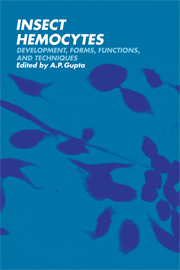Book contents
- Frontmatter
- Contents
- Preface
- List of contributors
- Part I Development and differentiation
- Part II Forms and structure
- Part III Functions
- 11 Hemocytes and growth in insects
- 12 Hemocytes and connective tissue: a critical assessment
- 13 Role of hemocytes in defense against biological agents
- 14 Cellular and humoral responses to toxic substances
- 15 Biochemical and ultrastructural aspects of synthesis, storage, and secretion in hemocytes
- 16 Changes in hemocyte populations
- Part IV Techniques
- Indexes
16 - Changes in hemocyte populations
Published online by Cambridge University Press: 04 August 2010
- Frontmatter
- Contents
- Preface
- List of contributors
- Part I Development and differentiation
- Part II Forms and structure
- Part III Functions
- 11 Hemocytes and growth in insects
- 12 Hemocytes and connective tissue: a critical assessment
- 13 Role of hemocytes in defense against biological agents
- 14 Cellular and humoral responses to toxic substances
- 15 Biochemical and ultrastructural aspects of synthesis, storage, and secretion in hemocytes
- 16 Changes in hemocyte populations
- Part IV Techniques
- Indexes
Summary
Introduction
The life of an insect may be uneventful, progressing from the immature to the adult with no trauma. On the other hand, the insect may face the trauma of injury, the lack of food, or the challenge of natural enemies. In this chapter I hope to discuss quantitative and qualitative changes in hemocyte populations during the life of an insect undergoing growth and development or exposed to injury or insult. Population changes will be determined primarily by changes in numbers (total hemocyte counts), in types of hemocytes (differential hemocyte counts), and in blood volume. Some emphasis will be placed on the wax moth, Galleria mellonella (L.) (Lepidoptera), on which much information has been obtained. In vivo studies will be emphasized.
Changes during development
Salt (1970), in his excellent review, The Cellular Defense Reactions of Insects, cautioned about the total hemocyte count (THC). He felt the THC must be used with caution because of inherent changes in the ratio of circulating to sedentary hemocytes and the changes owing to sampling procedures.
Orthoptera
Tauber and Yeager (1935) studied the THC in Orthoptera, Odonata, Hemiptera, and Homoptera. THCs from Blatta and Periplaneta were higher in females carrying oothecae than in “normal” females. Adults of Udeopsylla and Melanoplus (crickets and grasshoppers), Plathermis (a dragonfly), and Euschistus (a stink bug) had higher cell populations than nymphs. The authors felt that a gradual increase in hemocytes occurred during development.
In Periplaneta, the variation in cell counts was great (Smith, 1938). The lowest average count was 34,000/mm3 and the highest was 158,000/mm3.
- Type
- Chapter
- Information
- Insect HemocytesDevelopment, Forms, Functions and Techniques, pp. 475 - 524Publisher: Cambridge University PressPrint publication year: 1979
- 18
- Cited by



